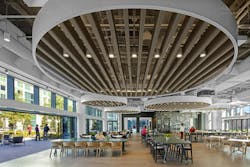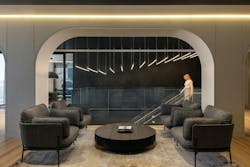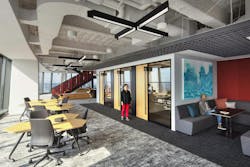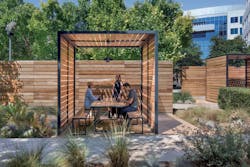9 workplace design trends for 2023
Hybrid, remote, hub-spoke-home, the death of the open plan—there are lots of ideas about the function, purpose and design of the post-pandemic office. But what are corporate decision-makers saying about the workplace in 2023 and how are employees responding?
HOK’s Kay Sargent and Tom Polucci recently participated in a LinkedIn Live where they shared insights from their conversations with corporate clients and answered audience questions about today’s workplace.
The discussion revealed several workplace trends for 2023, including:
1. The office regains prominence
While remote work levels remains higher than pre-Covid, Sargent referenced workforce and real estate data showing a continued uptick in office occupancy and demand as companies rebound from the pandemic.
“We are in an evolving situation, but we’re starting to see it level out,” she said. “There are concerns about the impact of the last three years on isolation, the quality of what is being produced, the lack of connection to colleagues, mentors and training and the long-term ramifications of all that.”
2. Design matters more than ever
One silver lining of the pandemic, said Polucci, is it forced companies to up their game when it comes to office design. Instead of just prioritizing cost, companies are asking for highly tailored spaces to recruit and retain talent, especially in today’s tight labor market.
“Clients are asking much more of us from a design perspective,” said Polucci. “They want space that is going to attract people back. They need a reason, and the space needs to look like something. I’m thrilled with this.”
3. Hospitality and luxury are difference makers
Sargent and Polucci both spoke of the trend to create bespoke spaces where employees can be productive and pampered with concierge-like services and high-end amenities.
“I can’t tell you how many times we hear references to airport lounges and the desire to make a space look like, say, the Delta lounge,” said Polucci. “A lot of those spaces are beautiful and very hospitality forward and focused, but they also provide spaces where you can collaborate with others or tuck away alone and be focused.”
Sargent noted that the 2023 workplace must be commute-worthy as getting to the office is often cited as the leading deterrent to working in-person.
“The office has to provide you with something you cannot get at home, and somebody providing you a service (like a concierge) can be a difference maker,” said Sargent. “It’s about taking the workplace to a hospitality level.”
4. Human-centric data > traditional CRE data
Traditional corporate real estate (CRE) data prioritized building occupancy and utilization to ensure every square foot was used efficiently. While those measurements still have value, they don’t reveal how people feel about the space.
“People are 80% of your costs,” Sargent said. “We need to recognize the importance of having happy, healthy, engaged, empowered workers who will work harder for you than somebody who’s disgruntled, unhappy or unhealthy. We need to focus more on human centric measurements, access to decision–makers, access to mentors, engagement, empowerment, a sense of purpose and belonging. In many ways, we’ve been focused on the wrong things.”
5. Spaces should be flexible to accommodate the day-to-day and “Easter Sunday”
Traditional CRE measurements do provide benefit in helping design teams create flexible workplaces that support smaller hybrid teams and the occasional all-staff meeting or big event.
“The notion of being in the office for five days a week, no longer exists,” said Polucci. “Today’s spaces need flexibility to expand and contract and allow people to be seen and heard whether they’re in the office or not.”
The question Polucci and his team most often get from their corporate clients is what happens when we want everyone in the office at the same time?
“We call it ‘Easter Sunday,’” said Polucci. “And if forces you to understand how the office could be used during all these different slices of different days.”
6. You can’t spell design without DEI and ESG
More and more companies are investing in diversity, equity and inclusion to meet the expectations of employees, customers and shareholders.
“If a company provides us with 15 different ESG (environmental, social and governance) priorities, often nine or ten of them are things we can positively impact through design,” said Sargent.
Within today’s workplace, it’s about creating spaces that are welcoming and supportive for everyone, regardless of their ability or background. For example, Sargent discussed HOK’s workplace design that accommodates people who are autistic, dyslexic or otherwise neurodivergent.
“We do that by embracing that we are all different and creating spaces where people have more options, more choices and more control. It’s essential for our mental and physical well-being and to function at a higher level.”
7. Outdoor amenities and movement are part of a healthy workplace
Wellness is top-of-mind in the workplace of 2023. At the bare minimum, wellness requires providing building occupants access to natural light and ways to be active within a space. Many companies are incorporating biophilia—such as green walls and nature-inspired art and furnishings—into the workplace. Some are taking it a step further by actually bringing the workplace outdoors.
“More and more of our workplace projects have an outdoor element,” said Polucci. “That connection to the outdoors is a key component to wellness, as is promoting movement. I can’t tell you a project now that does not have a stair element that connects multiple floors and encourages people to move through the space.”
8. Sustainability is wellness; Wellness is sustainability
Wellness will continue to cross paths with sustainability in 2023 as workplaces and office products emphasize human health and minimizing off–gassing, carbon and waste. Polucci spoke about flooring vendors that track the lifecycle of their products so they can be recycled instead of pitched and of furniture manufacturers placing QR codes on products to tracks their history and encourage their re-use.
“As that furniture gets reused over time, its story will continue,” he said. “We get to understand the value and impact these objects have over time. It’s an exciting opportunity to think about how we’re making spaces and design solutions in a mindful and holistic way.”
9. Employees have the upper hand—for now
So, how long will it last? Will these same trends extend into 2024 and beyond? Most are not going anywhere, said Polucci and Sargent, particularly trends related to healthier, more inclusive workplaces. But people’s approach to hybrid and remote work could change if the economy sours and labor supplies rise.
“If that happens, we could see a shift,” said Sargent. “With layoffs, people get more nervous about their jobs and are more likely to come into the office to be seen. Ultimately, the question is, who’s driving the bus—the employee or employer?”
For 2023—the early part, anyway—it’s the employee behind the wheel.



